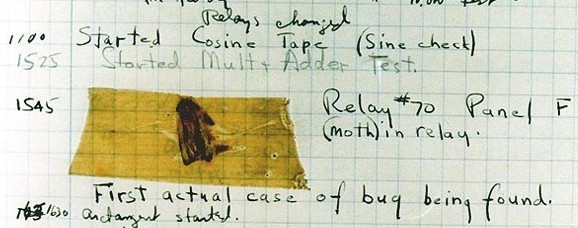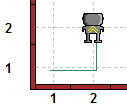

Nobody likes to talk about computer bugs. So, I will try to keep this lesson short. All I ask you to do is to read it I won't ask you to write programs with bugs!
The origin of the word bug in computer jargon is often attributed to an actual incident where a moth was found inside Harvard University's Mark II computer; apparently this moth had caused the computer to stop working. It was found by the team headed by renowned computer scientist, mathematician, and young naval officer Grace Murray Hopper, who went on to invent the concept of compiler languages in computer programming. Dr. Grace Hopper eventually rose in the U.S. naval hierarchy to the rank of Rear Admiral.
The moth was preserved, taped into Hopper's log book, as shown below. Interestingly, the log book included a note saying, "First actual case of bug being found." as you can see.

Actually, the word bug in a technological context is attributed by the Oxford English Dictionary to Thomas Edison. According to the Oxford Dictionary, the following text can apparently be found in the March 11, 1889 edition of the Pall Mall Gazette:
Mr. Edison, I was informed, had been up the two previous nights discovering 'a bug' in his phonograph - an expression for solving a difficulty, and implying that some imaginary insect has secreted itself inside and is causing all the trouble.
It thus appears that the original 'bug', though it was indeed an insect, was in fact imaginary.
Unfortunately, computer bugs, while they are not insects, are also not imaginary.
In computer jargon, a bug is an error that causes a program to behave in an unexpected way. If you are writing computer programs, you are going to have bugs in them sooner or later - everybody does. Good programmers seek to "remove" bugs or "fix" them as soon as they find that their program behaves unexpectedly.
RUR-PLE has been designed to help you find bugs.


 . This is similar to what people refer to as setting a
breakpoint in a computer program.
. This is similar to what people refer to as setting a
breakpoint in a computer program.
 .
.
 . The more you move the slider to the right, the faster
the program will execute. You can only adjust the speed at the beginning of
the program, at which point it will be set for the entire program. For long
running program, you can first start running the program quickly, pause it
when you reach the point near the unexpected behaviour (the "bug"), and then
carefully step through each instruction one at a time.
. The more you move the slider to the right, the faster
the program will execute. You can only adjust the speed at the beginning of
the program, at which point it will be set for the entire program. For long
running program, you can first start running the program quickly, pause it
when you reach the point near the unexpected behaviour (the "bug"), and then
carefully step through each instruction one at a time.
 .
.

 .
.
This should be more than enough for now. As you learn more about programming, you will learn other tricks that will help you find bugs and get rid of them!